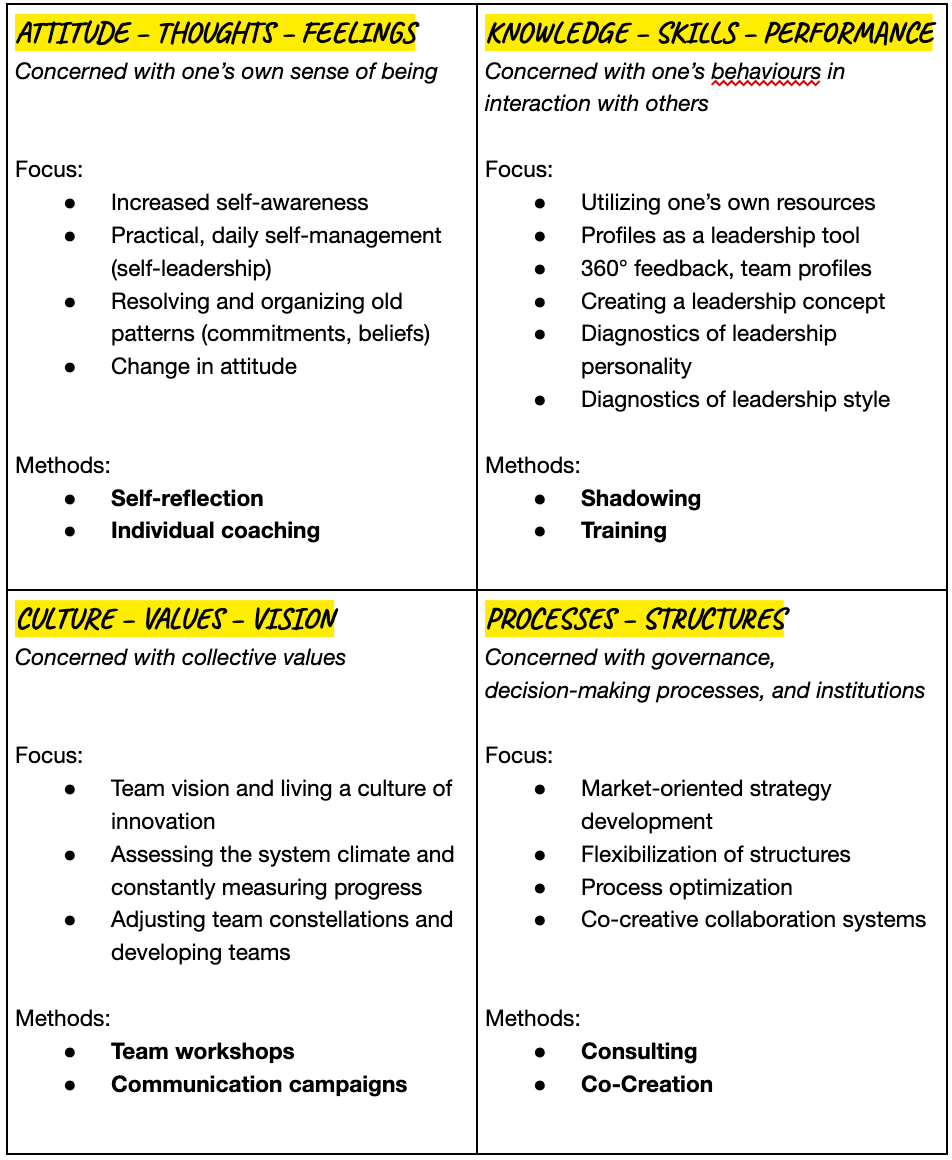This is a joint post with authentica coaching.
Our world is in motion. The easier it becomes for us to flexibly manage the newly emerging complexity, the sooner we can identify the next viable evolutionary step. This applies to individuals as well as organizations, as they follow similar evolutionary processes.
What is Organizational Development?
In discussions with CEOs and HR leaders, we often hear about the need for change management, i.e. the adaptation or modification of existing structures and processes with the involvement of employees. Organizational development includes, but goes beyond, change management. In this case, we refer to a holistic approach that sustainably raises the organization to a higher level. This means that in addition to existing structures and processes, relationships, cultural elements, behaviors and mindsets are challenged. And this rethinking is initiated at all levels of the organization. Much more changes than just structures or processes, because people develop themselves and their environment from the inside out. Everything that happens in this process is a growth accelerator.
Which Models Are Suitable for Developing a Complex System?
Every development goes through individual stages in a specific order. These stages build on each other and cannot be skipped. They apply to individuals as well as to collectives (organizations and cultures). Development always begins on the inside with the attitude of the individual and the shared values, and then manifests itself on the outside through behavior and the resulting structures and processes.
For us, including all these dimensions represents an integral view of development. This perspective enables us to decode organizational and interactional complexity more easily and to understand and reinforce development dynamics.
In the integral perspective, we include all four dimensions mentioned: Internal, External, Individual and Collective (see Figure 1). They interlock organically and are mutually dependent; nothing is neglected or emphasized.
This allows us to recognize which intervention is helpful at which moment, taking into account the effects in the respective quadrants. Just as the mixture of water, light, soil and nutrients must fit together for the plant, our focus is on the appropriate composition of the developmental steps in all four dimensions for the organization.
The stages of development (maturity model) were defined by Prof. Clare Graves and later, after worldwide empirical studies by Chris Cowan and Don Beck, became known as Spiral Dynamics and were embedded in the integral system by Ken Wilber. By understanding these developmental steps, it is possible to contextualize situations and circumstances and make them discussable.
We call the embedding of the four dimensions of development in the stages of development the integral development model (see Figure 1). This model enables us to support the individual and the entire system appropriately in organizational development.
Figure 1; For completeness, it should be mentioned that in this graphic, the Beige and Purple stages that come before the Red stage aren’t shown. Companies in the Western world are usually in the stages from Red to Green.
How to Start?
Every integral project begins with an analysis of the current status of the organizational unit in the four quadrants and maturity levels. This creates immediate orientation and a common language for everyone involved.
This initial stage often brings clarity about which parts of the company are still influenced by Blue, Red, or even Purple.
Next, we develop a joint assessment of the target state leading to a precise definition of objectives at the next maturity levels. At this point, ideally, the entire management team of the organizational unit begins to open up to the next step in their development. This period of reflection allows them to profoundly understand the themes that need to be developed, themes that until now may have seemed unrelated. It becomes clear why certain topics are prioritized over others and what steps need to be taken next.
The objective frequently mentioned is to progress to the Orange stage. This involves becoming faster, more efficient, more flexible, and more innovative, developing leaner processes along value chains, and deepening customer integration into the product development process and market orientation.
Parallel to the initial steps of the group work, the top manager of the organizational unit begins working with their coach, because integral work means seeing the company as a reflection of one's inner life.
Meaningful Interventions on the Path to Orange
Every step into the next stage of development requires appropriate interventions. Therefore, the transition from Blue to Orange fundamentally needs different interventions than the previous transition from Red to Blue. Figure 2 shows suitable examples from our practical experience for the path to Orange.
The Four Dimensions of the Organization on the Path to Orange

Figure 2
Every organization will, at some point, move through the stages of development. However, since these steps sometimes take decades, it is worth leveraging integral knowledge and actively engaging in further development. Therefore, integral organizational development acts as a catalyst for rapid development results and successful transformation.
